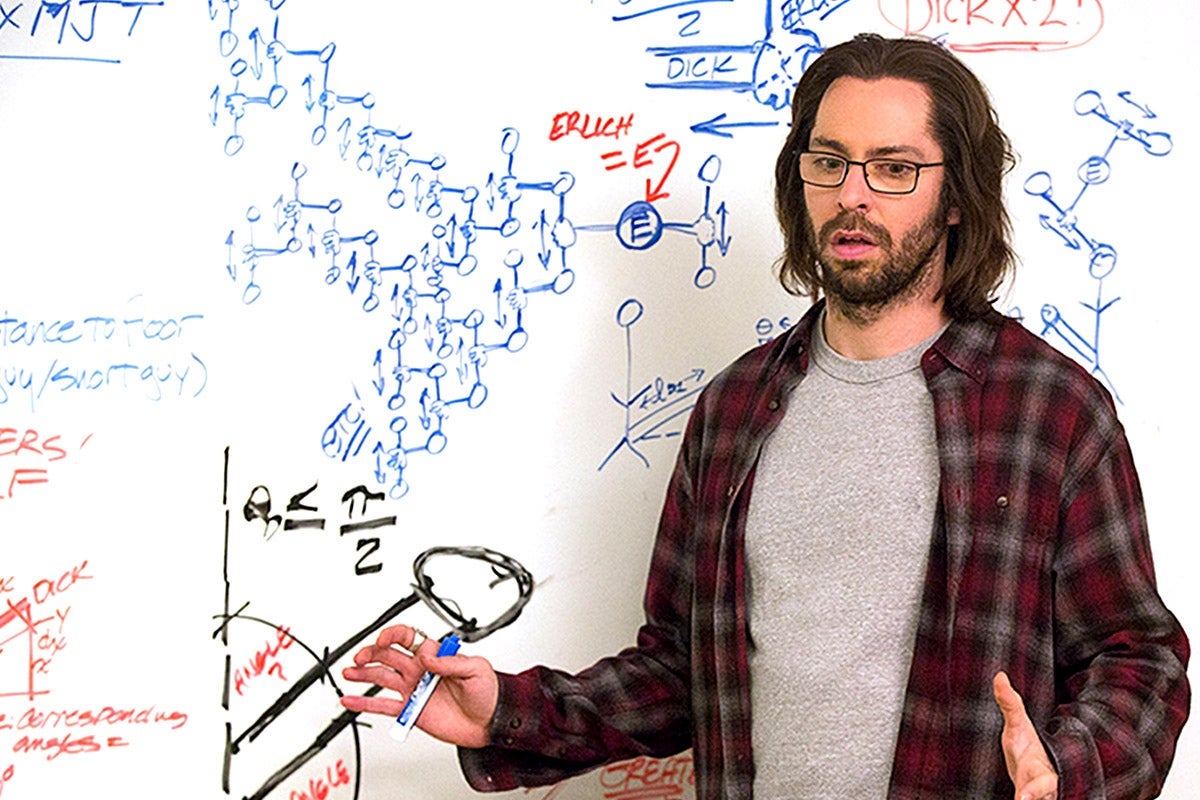
Martin Starr in Silicon Valley.
Photo illustration by Slate. Photo by HBO.
HBO’s Silicon Valley recently wrapped up its six-year run, which for some viewers means it’s finally time to dig into the series, a satire of startup culture, the tech industry, and the ambitious if easily overwhelmed nerds who populate both. Silicon Valley was co-created by Mike Judge (Office Space, King of the Hill), but while early press reports were eager to note his own brief career at a tech startup in the 1980s, the comedy became known for its hypercurrent depiction of the Valley over the past half-decade. In the first season, that meant name-checking the now-defunct Valleywag blog, a Gawker offshoot that focused on tech-centric gossip, and gently spoofing venture capitalist (and eventual Gawker killer) Peter Thiel’s offerings of $100,000 to college students who drop out of school. By its final season, the core characters—entrepreneur Richard (Thomas Middleditch), business adviser and nurturer-in-chief Jared (series MVP Zach Woods), and rival coders Gilfoyle (Martin Starr) and Dinesh (Kumail Nanjiani)—contend with the possibility of being bailed out by blood money (paralleling the real Silicon Valley’s reliance on Saudi investment, among other ethical issues), along with the irrefutable fact that the very quality that makes their product so powerful also makes the world a demonstrably worse place.
Slate’s Gateway Episodes series exists in part to persuade newcomers that a TV show is worth diving into, however formidable it may look from the outside. But I’m not sure that I’d recommend Silicon Valley as a whole. The series does boast a strong comedic ensemble (rounded out by T.J. Miller, who was fired from the show after Season 4, and recurring guest star Jimmy O. Yang), and no other show has attained so much mainstream success while embracing inscrutable tech jargon with such abandon. But despite its tonal and thematic shifts over the seasons, for most of its run Silicon Valley has relied on the same skepticism of PR bluster and virtue-signaling; the same wang-centric, no-homo humor; even the same extreme-emotional-roller-coaster plot structures. Add the show’s obliviousness when it comes to female tech workers and its often off-putting depictions of Asians and Asian Americans, and it can become hard to remember Silicon Valley’s initial charms.
Still, for those curious about why Silicon Valley became such a cultural phenomenon for those within the industry (like noted fan Bill Gates) and without, you can get a pretty good sense from the Season 1 finale, “Optimal Tip-to-Tip Efficiency.” The show’s pilot is an altogether serviceable introduction, summarizing Silicon Valley’s the-coders-are-the-new-artists, the-geeks-shall-inherit-the-earth ethos: “For thousands of years, guys like us have gotten the shit kicked out of us. But now, for the first time, we are living in an era where we can be in charge and build empires.” But Richard and company are also striving to build something original and significant in a hypercompetitive, all-or-nothing ecosystem where the apex predators are always prepared to stomp on or slurp up prey. That bigger picture is much easier to see in “Optimal Tip-to-Tip Efficiency,” which not only offers one of the most convincing encapsulations of the series’s David vs. Goliath worldview (increasingly complicated in future seasons), but also some of the best character-based storylines of the season, as well as a three-minute, four-man handjob-math gag that’ll convince you that this show is either extremely your jam or decidedly not so.
“Optimal Tip-to-Tip Efficiency” is the second half of a two-parter that takes place during a startup competition, but it’s not necessary to watch the (weak) first installment, since the finale works as a mini-movie. At the start of the episode, the peacocking CEO of tech giant Hooli (Matt Ross) presents a compression software just as good as the one Richard and his team had hoped to wow the judges with—only Hooli’s comes attached to the email, search engine, and sundry other services millions of consumers already use. (Plus, they’ve got Shakira to entertain the crowd.) The collective freakout among Richard and his employees, who now face the imminent extinction of their company, leads them to act out in ways both funny and revealing: Jared scrambles for app ideas to pivot to, Miller’s Erlich Bachman launches a smear campaign against Hooli’s leadership, Gilfoyle and Dinesh consider abandoning ship ASAP, and Richard is frozen in his usual panic-stricken paralysis until an escape hatch occurs to him. The episode’s resolution is stirringly jubilant, but its real triumph may be the group’s intense calculations, complete with equations on whiteboards involving penis-to-floor variables and complementary shaft angle to determine how Erlich might jerk off every single member of the audience during the 10 minutes that they have for the presentation. Devising a solution to a seeming impossibility: On Silicon Valley, there’s no higher calling, no matter how many dicks are involved.
Available to stream on Hulu.
from Slate Magazine https://ift.tt/2sdfWHw
via IFTTT
沒有留言:
張貼留言